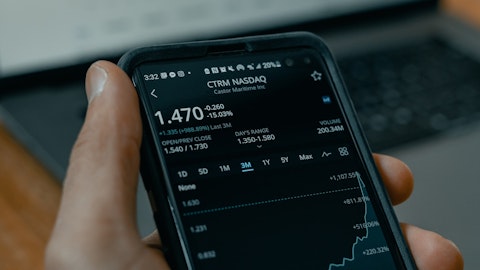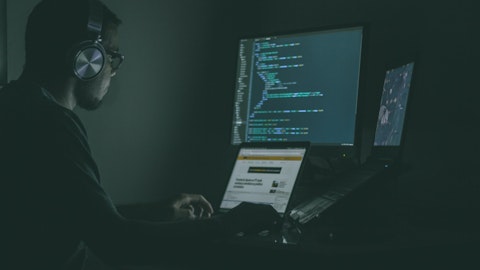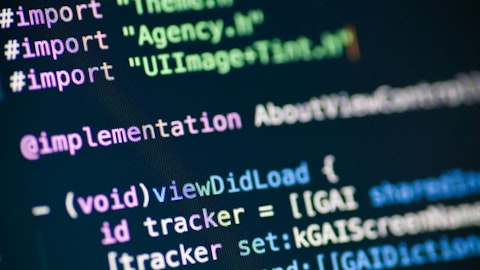Unidentified Analyst: And then just to touch on what you’re seeing in the market from like a competitive perspective, given the more difficult funding environment for private ID verification providers. Are you seeing competitive benefits in the pipeline as a result of the uncertain macro, so kind of a tailwind given the macro environment?
Max Carnecchia: I think the answer for sure is yes. If we went back in the Wayback Machine, two and half, three years ago, you couldn’t open crunch base any week without reading about a new company that was being created to take on the identity category, you couldn’t go a week without seeing additional eye popping funding rounds. And most of those new formed competitors, they spent a lot of that money on sales and marketing and they were not investing in innovation and things that were both proprietary and differentiated. And over the course of the last two years, we’ve absolutely seen that come home to roost. And so as I said, when Chad asked the question, there’s still uncertainty in the economy, there’s still a lot of geopolitical stuff going on.
But the lay of the land, the competitive lay of the land for us has shifted and we believe shifted in our favor. I mean when you’re going to look around as a — you’re a mobile operator, you’re a bank, you’re a healthcare institution, who are you going to partner with, who are you relying on, who’s going to be able to kind of come out the other side of this and not just have great product but be able to support you and have the vendor viability. And I’ll stand on the FY23 10-K, that’s vendor viability.
Operator: Your next question today will come from Owen Rickert of Northland Capital Markets.
Owen Rickert: This is Owen on for Mike Grondahl. I just have two questions. So first, what are your priorities for Mobile ID in 2024?
Max Carnecchia: Can you be a little more specific as to what you mean by that?
Owen Rickert: I guess just priorities going forward in terms of go-to-market, what you’re doing to improve the product, et cetera?
Max Carnecchia: We’re really excited about the progress that we’re making with MiVIP, right? So this end-to-end orchestration, low-code no-code environment, our ability to take on these really [gnarly] problems for regulated organizations. I talked about what those vertical industries are. But to be able to do that, not just for onboarding journeys and to get new accounts open but what is often referred to as in life journeys, right? The ability to help somebody with a password reset, you forgot your credentials instead of sitting for a half hour on a call center line and burning up a lot of time and having a terrible experience using MiVIP and now MiPass the multimodal biometric identity authentication system, those are great opportunities for us.
And as we’ve talked about in the past, our model is land and expand, right? You land the initial piece of business with a bank or a mobile operator and inevitably within a year or two, we’re in two, three, four different use cases. Some of those are onboarding journeys, which are transaction driven. But now with what we’re doing with MiPass and, of course, the ID R&D biometrics and liveness componentry, having recurring revenue associated with more of a conventional subscription model we’re really excited about how that’s growing the business, and not just what we’re going to do for the rest of FY24 but really the future of this business over the intermediate term.
Owen Rickert: And then lastly, are there any incremental updates on the sales team?
Max Carnecchia: Well, coming into FY24, as we just said for Jacob, we’ve made some additional investments in what we’re doing with Check Fraud Defender and now MiControl, so putting more, if you will, logs on the fire to really kind of get that cooking. On the identity side of the business, we’ve been investing in really kind of upgrading the team. We’re probably halfway through a pretty big transformation, right? If you go back in the way back machine before we came together with HooYu and had MiVIP, we were basically selling a point solution where we would be able to do identity verification using a government issued identity document and a facial liveness test. Now with MiVIP, I’ve got an end-to-end enterprise solution that can be used in a lot of different places by a lot of different businesses.
And the sales motion, the positioning of that, who we’re targeting as far as the buyer cohort within our target accounts, all of those things have changed and we’ve been making changes to our team and our selling motions to exploit that. And then with ID R&D, separately, very much the selling of those componentry just again bringing — it’s not huge investments but going from three sellers to five sellers makes a really big difference and to have those folks located in places like Singapore or Brazil or Eastern Europe, just because that’s where the action is.
Operator: [Operator Instructions] And our next question will come from Allen Klee of Maxim.
Allen Klee: Question on your guidance, I think you’re guiding to non-GAAP operating margin of 30% to 31%. I think that compares to 31% you did in fiscal ’23. So my question is, if the mobile identity business is going to move from losing money to breakeven during the year, so that should improve results. What’s the offset that is making margins not go up?
Dave Lyle: It’s a couple of different — just doing the high-level math first. If you take our revenue guidance and assume kind of gross margin similar to 2023, looking at 2024 and backing into operating expense, we’re growing operating expense somewhere in the kind of $7 million range year-over-year, $23 million to $24 million. Most of that it’s going to be investment in R&D from a cost perspective. And that’s going to be a combination of products that we’re investing in, particularly CFD but also in some of the other kind of earlier stage growth products that we have.
Allen Klee: And then in terms of capital allocation, I think the last call, you guys said once you got out of a blackout, you would consider a buyback. How are you thinking about that today?





